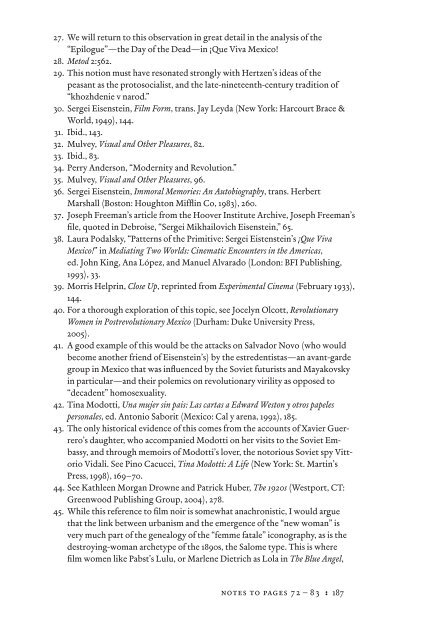In Excess: Sergei Eisentein's Mexico - Cineclub
In Excess: Sergei Eisentein's Mexico - Cineclub
In Excess: Sergei Eisentein's Mexico - Cineclub
You also want an ePaper? Increase the reach of your titles
YUMPU automatically turns print PDFs into web optimized ePapers that Google loves.
27. We will return to this observation in great detail in the analysis of the<br />
“Epilogue”—the Day of the Dead—in ¡Que Viva <strong>Mexico</strong>!<br />
28. Metod 2:562.<br />
29. This notion must have resonated strongly with Hertzen’s ideas of the<br />
peasant as the protosocialist, and the late-nineteenth-century tradition of<br />
“khozhdenie v narod.”<br />
30. <strong>Sergei</strong> Eisenstein, Film Form, trans. Jay Leyda (New York: Harcourt Brace &<br />
World, 1949), 144.<br />
31. Ibid., 143.<br />
32. Mulvey, Visual and Other Pleasures, 82.<br />
33. Ibid., 83.<br />
34. Perry Anderson, “Modernity and Revolution.”<br />
35. Mulvey, Visual and Other Pleasures, 96.<br />
36. <strong>Sergei</strong> Eisenstein, Immoral Memories: An Autobiography, trans. Herbert<br />
Marshall (Boston: Houghton Miffl in Co, 1983), 260.<br />
37. Joseph Freeman’s article from the Hoover <strong>In</strong>stitute Archive, Joseph Freeman’s<br />
fi le, quoted in Debroise, “<strong>Sergei</strong> Mikhailovich Eisenstein,” 65.<br />
38. Laura Podalsky, “Patterns of the Primitive: <strong>Sergei</strong> Eistenstein’s ¡Que Viva<br />
<strong>Mexico</strong>!” in Mediating Two Worlds: Cinematic Encounters in the Americas,<br />
ed. John King, Ana López, and Manuel Alvarado (London: BFI Publishing,<br />
1993), 33.<br />
39. Morris Helprin, Close Up, reprinted from Experimental Cinema (February 1933),<br />
144.<br />
40. For a thorough exploration of this topic, see Jocelyn Olcott, Revolutionary<br />
Women in Postrevolutionary <strong>Mexico</strong> (Durham: Duke University Press,<br />
2005).<br />
41. A good example of this would be the attacks on Salvador Novo (who would<br />
become another friend of Eisenstein’s) by the estredentistas—an avant-garde<br />
group in <strong>Mexico</strong> that was infl uenced by the Soviet futurists and Mayakovsky<br />
in particular—and their polemics on revolutionary virility as opposed to<br />
“decadent” homosexuality.<br />
42. Tina Modotti, Una mujer sin pais: Las cartas a Edward Weston y otros papeles<br />
personales, ed. Antonio Saborit (<strong>Mexico</strong>: Cal y arena, 1992), 185.<br />
43. The only historical evidence of this comes from the accounts of Xavier Guerrero’s<br />
daughter, who accompanied Modotti on her visits to the Soviet Embassy,<br />
and through memoirs of Modotti’s lover, the notorious Soviet spy Vittorio<br />
Vidali. See Pino Cacucci, Tina Modotti: A Life (New York: St. Martin’s<br />
Press, 1998), 169–70.<br />
44. See Kathleen Morgan Drowne and Patrick Huber, The 1920s (Westport, CT:<br />
Greenwood Publishing Group, 2004), 278.<br />
45. While this reference to fi lm noir is somewhat anachronistic, I would argue<br />
that the link between urbanism and the emergence of the “new woman” is<br />
very much part of the genealogy of the “femme fatale” iconography, as is the<br />
destroying-woman archetype of the 1890s, the Salome type. This is where<br />
fi lm women like Pabst’s Lulu, or Marlene Dietrich as Lola in The Blue Angel,<br />
notes to pages 72 – 83 : 187


